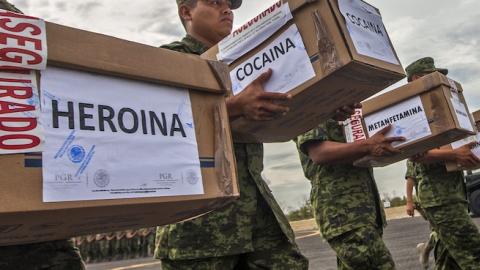Moving in the shadow of today’s news from the United Nations concerning Colombia’s surging coca crop and the portent of a return of the cocaine epidemic to the American scene (according to U.S. sources, production is up 48 percent over the past two years, with more on the horizon), the White House quietly posted some even more dramatic news concerning Mexico and heroin.
Though the results are not a surprise to drug policy experts who have anticipated the results of the annual estimate conducted by the intelligence community (indeed, the results have been circulating in the interagency and on Capitol Hill since summer), the magnitude of the increase finally revealed generates a shock.
In a single year, between 2013 when the estimated amount of pure heroin coming from the single largest supplier to the U.S. market was set at 26 metric tons, the production out of Mexico has risen a stunning 62 percent, with an estimated 42 metric tons of potential pure heroin. That amount will surely increase as the product is cut and spread through the growing network of Mexican cartel-allied gangs now dominating U.S. streets.
The implications are as devastating as the amount. The domestic spread of Mexican Transnational Criminal Organizations has been documented by the Drug Enforcement Administration (DEA), becoming “the greatest criminal drug threat to the United States.” Mexican heroin has traditionally been a product known as “black tar,” a relatively low-purity form of the drug that is principally consumed through injection. That has changed.
The DEA notes that Mexican cartels appear to have learned the processing techniques of Colombian traffickers, and are now capable of providing pure white heroin powder that can be snorted, as well as injected.
This means that heroin initiates, trying the drug and concerned about the adverse consequences of injection, are lured into the condition of addiction far more readily, only to find themselves injecting as their tolerance grows.
The world is by now well aware of the consequences of heroin use in America, the dramatic increase in use, addiction, and now overdose deaths, spiking sharply up since 2010.
We should be even more concerned about the heroin increase. The sharp rise in heroin consequences has been driven by Mexican production from the years prior to 2014, which saw the 62 percent increase. That means that the consequences of 42 metric tons in the U.S. market are just now being felt, and have yet to be captured in measurements, which are retrospective.
In a further blow, we also learned that, notwithstanding assurances from drug legalizers that legal, commercial marijuana would undermine the cartel black market, the Mexican marijuana crop has also been rising, to 13,000 hectares of cultivation, up from 11,500 in 2012 (albeit the 2014 results are not yet posted).
American past month heroin use has increased sharply between 2013 and 2014, from 289,000 current users to 435,000, according to national surveys, an increase of 51 percent. Surely there will be a greater number of overdose deaths looming, especially when we acknowledge that total American consumption of heroin has in the past been estimated at around 18 metric tons.
The die is already cast for even more heroin abundance, which is already at unprecedented levels of low cost and high purity. Simply put, Americans have never experienced this amount of potential heroin, and this time, coming from a single source.
In 2013, there were an unprecedented 46,471 deaths from drug overdoses in the U.S., 24,492 (53 percent) of them attributed to opiates. Of those, prescription pills accounted for 16,235, but that figure is steady since 2010. Heroin, by contrast, has quadrupled as a cause of drug-induced deaths since 2007, rising from 2,402 in 2007 to today’s 8,257.
Yet the White House has been focused not on heroin, but rather the misuse of prescriptions, which, while devastating, is but one dimension of today’s overdose epidemic rise, which is largely a function of Mexican heroin.
Why have they preferred the alternative narrative, and remained silent about the heroin surge? One reason could well be political. A focus on prescription misuse leads to a story line about doctor training, the dispensing of antidotes, and promised features (yet to be realized) of the Affordable Care Act.
That narrative turns away from confronting the problems of the border, where heroin seizures have soared, as well as significant increases in immigrant flow and dispersal throughout the country from Mexico and Central America. And lastly, it evades facing this Administration’s plan to release thousands of convicted felon prisoners, largely dangerous drug traffickers, perhaps capable of turning once again to the marketing of cocaine and heroin to the vulnerable.
This heroin news represents a major policy failure at the hands of the Obama Administration, wedded as they are to “ending the drug war” and failing to pursue strategies of supply reduction not only at home, but in the not-so-distant lands where drugs are increasingly produced and aimed at the U.S. heartland.

















